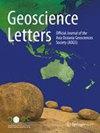来自 CYGNSS、MODIS、Landsat 和商业卫星图像的内陆水观测数据的空间比较
IF 4.3
3区 地球科学
Q1 GEOSCIENCES, MULTIDISCIPLINARY
引用次数: 0
摘要
准确及时的内陆水体范围和位置数据是支持各种水文应用和水资源管理的基础信息。最近,旋风式全球导航卫星系统(CYGNSS)已成为划定内陆水域的一种有前途的工具,因为旋风式全球导航卫星系统的八颗微型卫星带有无源双稳态雷达,可获取全球定位系统(GPS)反射的 L 波段信号(即机会信号),从而观测到旱地与湿地截然不同的地表反射率特征。本研究利用三个地球观测系统对 2019 年北纬 24 度至 37 度之间的美国毗连地区进行了 1 公里水掩蔽基线比较:CYGNSS(即我们的基线水掩蔽数据)、中分辨率成像光谱仪(MODIS)(即陆地水掩蔽数据)和陆地卫星全球地表水产品(即 Pekel 数据)。利用混淆矩阵统计和光学高分辨率商业卫星图像对 1 千米对比水掩模的空间性能进行了评估。当对 CYGNSS 数据的 8 个子流域采用二元阈值镶嵌法时,混淆矩阵统计得到了改善,例如 F1 分数提高了 34%。此外,内陆水域与集水区面积之比的性能指标显示,无论观测哪个子流域,CYGNSS、MODIS 和 Landsat 的内陆水域面积估算值相差均在 2.3% 以内。总之,这项研究为了解基于光学(可见光)和雷达(全球导航卫星系统反射测量法,GNSS-R)的卫星地球观测得出的内陆水域掩模的空间相似性和差异提供了宝贵的见解。本文章由计算机程序翻译,如有差异,请以英文原文为准。
Spatial comparison of inland water observations from CYGNSS, MODIS, Landsat, and commercial satellite imagery
Accurate and timely inland waterbody extent and location data are foundational information to support a variety of hydrological applications and water resources management. Recently, the Cyclone Global Navigation Satellite System (CYGNSS) has emerged as a promising tool for delineating inland water due to distinct surface reflectivity characteristics over dry versus wet land which are observable by CYGNSS’s eight microsatellites with passive bistatic radars that acquire reflected L-band signals from the Global Positioning System (GPS) (i.e., signals of opportunity). This study conducts a baseline 1-km comparison of water masks for the contiguous United States between latitudes of 24°N-37°N for 2019 using three Earth observation systems: CYGNSS (i.e., our baseline water mask data), the Moderate Resolution Imaging Spectroradiometer (MODIS) (i.e., land water mask data), and the Landsat Global Surface Water product (i.e., Pekel data). Spatial performance of the 1-km comparison water mask was assessed using confusion matrix statistics and optical high-resolution commercial satellite imagery. When a mosaic of binary thresholds for 8 sub-basins for CYGNSS data were employed, confusion matrix statistics were improved such as up to a 34% increase in F1-score. Further, a performance metric of ratio of inland water to catchment area showed that inland water area estimates from CYGNSS, MODIS, and Landsat were within 2.3% of each other regardless of the sub-basin observed. Overall, this study provides valuable insight into the spatial similarities and discrepancies of inland water masks derived from optical (visible) versus radar (Global Navigation Satellite System Reflectometry, GNSS-R) based satellite Earth observations.
求助全文
通过发布文献求助,成功后即可免费获取论文全文。
去求助
来源期刊

Geoscience Letters
Earth and Planetary Sciences-General Earth and Planetary Sciences
CiteScore
4.90
自引率
2.50%
发文量
42
审稿时长
25 weeks
期刊介绍:
Geoscience Letters is the official journal of the Asia Oceania Geosciences Society, and a fully open access journal published under the SpringerOpen brand. The journal publishes original, innovative and timely research letter articles and concise reviews on studies of the Earth and its environment, the planetary and space sciences. Contributions reflect the eight scientific sections of the AOGS: Atmospheric Sciences, Biogeosciences, Hydrological Sciences, Interdisciplinary Geosciences, Ocean Sciences, Planetary Sciences, Solar and Terrestrial Sciences, and Solid Earth Sciences. Geoscience Letters focuses on cutting-edge fundamental and applied research in the broad field of the geosciences, including the applications of geoscience research to societal problems. This journal is Open Access, providing rapid electronic publication of high-quality, peer-reviewed scientific contributions.
 求助内容:
求助内容: 应助结果提醒方式:
应助结果提醒方式:


